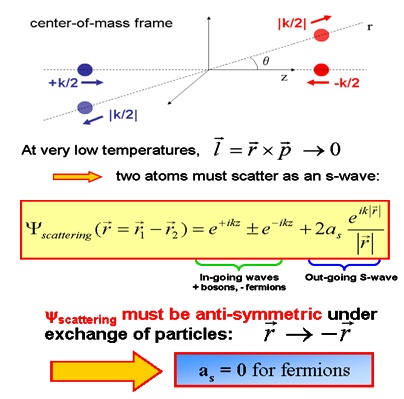Ultra-cold Fermions for Interferometry
Ultra-cold atoms, and fermions in particular, have
a number of advantages as the particle of choice for matter-wave
interferometers. Their low temperature reduces the transverse momentum spread,
so that they behave similar to single mode lasers, and their low velocity
permits long integration times and local measurements. While the short
deBroglie wavelength of atoms makes them attractive for
interferometry, atoms also experience important inter-atom interactions. These
interactions affect the internal energy of the atoms and hence the interferometric
phase. Accurate interferometric measurements are consequently
dependent on the atomic density, which is generally difficult to reproducibly
control at the requisite level.
Bosons
Ultra-cold bosons, or BEC, are the matter-wave equivalent of
photons in a laser. However, they suffer from large atom-atom interactions,
though a careful choice of element, atomic state, and the use of Feschbach
resonances can lower these appreciably. Ultra-cold boson interferometers will
ultimately be limited by their atom-atom interactions.
 Fermions
Fermions
Atom-atom interactions between ultra-cold identical fermions are
negligible. S-wave scattering, the dominant interaction at ultra-cold
temperatures, is forbidden by the anti-symmetry of identical fermion
wavefuntions. P-wave scattering is strongly suppressed by the ultra-cold
momentum spread of the atoms. The lack of any significant interactions make
ultra-cold degenerate fermions ideal candidates for precision matter-wave
interferometry.
This same lack of interaction between identical ultra-cold
fermions also means that fermions require special care when cooling. The
standard technique of evaporative cooling does not work
because the fermionic atoms cannot rethermalize with themselves, after the
"hot" atoms have been selectively removed. Instead, one must have at second
type of non-identical particle around such as a second fermion spin state or
another atomic species. In our apparatus, we use bosonic 87Rb to
sympathetically cool the fermionic 40K.
